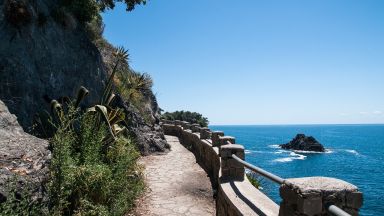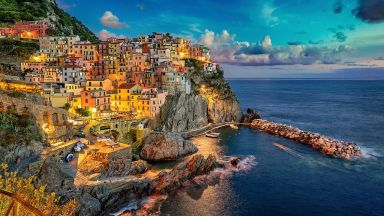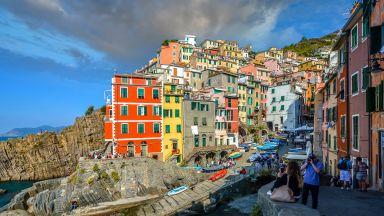Self Guided Walking Tour of Genoa (with Maps!)
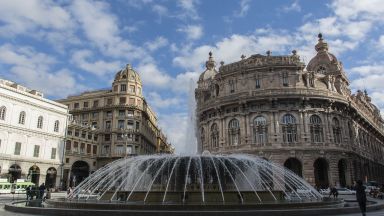
This website uses affiliate links which earn a small commission at no additional cost to you.
Welcome to Genoa, a city steeped in history, culture, and captivating charm. While renowned cities like Venice, Florence, and Rome tend to capture the attention of international tourists, Genoa stands as a destination that merits greater recognition for those in search of genuine Italian encounters.
Nestled on the Ligurian Sea, Genoa is a hidden gem waiting to be explored—a city that boasts a rich maritime heritage, a labyrinthine medieval quarter, and a vibrant mix of old-world elegance and modern flair. Join us as we meander through its alleys, uncover its hidden treasures, and immerse ourselves in the tales of a city that has shaped Italy’s narrative for centuries.
As you embark on this walking tour, you’ll step into the footsteps of explorers, merchants, and artisans who have left their indelible mark on its cobbled streets and grand piazzas.
Casa della Famiglia Colombo (Columbus' House)
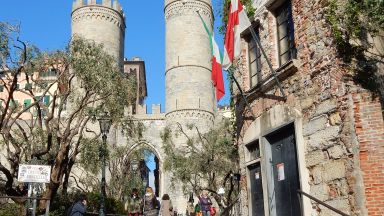
The Christopher Columbus House stands today as a faithful 18th-century reconstruction of the very dwelling where Christopher Columbus spent his formative years. Situated beyond the precincts of Genoa’s 14th-century fortifications, this location witnessed intense Renaissance-era urban development, predominantly marked by the emergence of public housing.
Born in 1451, Columbus’s presence in this dwelling is attested by historical records, placing his residency here between roughly 1455 and 1470. During this period, the house encompassed two, and perhaps even three, stories. The ground floor featured a shop, with the entrance situated to the left of the shop.
Historian Marcello Staglieno’s insights suggest that the original house likely met its demise during the French Bombardment of Genoa in 1684. However, its revival commenced in the early 18th century, rooted in the remnants of the original structure. This renewed incarnation reached a soaring height of five stories, yet this elevation was achieved by anchoring upper stories onto neighboring buildings. With the eventual demolition of these neighbouring structures around 1900, as part of the Via XX September construction, the building underwent alterations. Its uppermost stories were dismantled, resulting in the present-day stature of two stories.
At present, the premises operate as a museum, offering an immersive experience into Columbus’s world and era. The central location, coupled with convenient nearby parking, renders it a favoured rendezvous point for the local Genovese community.
Location: Christopher Columbus' House, Via di Porta Soprana, Genoa, Metropolitan City of Genoa, Italy | Website
Read more about Christopher Columbus House
Porta Soprana
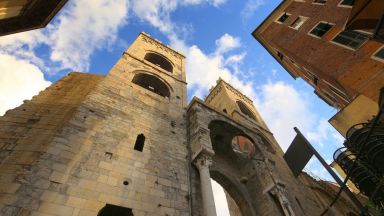
During the year 1155, as an integral component of a comprehensive defensive wall system, Genoa undertook the construction of three grandiose gates. Porta Soprana stands as one of this trio, joined only by Porta dei Vacca as the sole survivors of this endeavor. These gates are distinguished by their striking circular towers, a shared architectural feature that binds them together.
Porta Soprana, an enduring monument of historical significance, stands as a testament to Genoa’s strategic approach to fortification. Its counterpart, Porta dei Vacca, stands in harmony, embodying the city’s resolute dedication to safeguarding its boundaries.
Location: Porta Soprana, di Soprana, Via San Pietro della Porta, Genoa, Metropolitan City of Genoa, Italy
Read more about Porta Soprana City Gate
Jesuit church of Santi Ambrogio e Andreaw
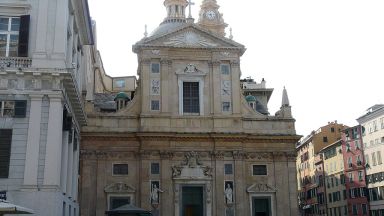
During the tumultuous 6th century, Bishop Onorato of Milan found himself in a precarious situation, fleeing from the Longobard persecutions that swept through the region. Seeking refuge, he embarked on a journey that led him to the welcoming shores of Genoa. It was here, amidst the embrace of this coastal city, that Bishop Onorato laid the foundation for the Church of Saint Ambrose, a name that held deep significance as Ambrose stood as the revered patron Saint of Milan.
The early days of the church were marked by a sense of communal devotion, as the Milanese community rallied around this sanctuary. However, as the centuries passed, circumstances shifted. Abandoned by its original congregants in the 7th century, the church would find new life in the 16th century under a different stewardship—the Jesuits.
In 1522, a transformative chapter began for the Church of Saint Ambrose as the Jesuits undertook the task of rebuilding the aging structure. Guided by the visionary designs of architect Giuseppe Valeriano, the church underwent a remarkable metamorphosis. The façade itself underwent a profound transformation in the late 19th century, reflecting the intricate tapestry of influences that shaped its identity. Inspired by the artistic essence of Rubens, the façade took on a Baroque visage, adorned with sculptures of Sant Ambrogio and Sant Andrea, masterfully crafted by the skilled hands of Michele Ramognino.
Stepping within the hallowed walls, one is greeted by a symphony of artistic expressions that narrate stories of faith and devotion. The intricate frescoes adorning the nave and dome, meticulously painted by Giovanni Battista Carlone, infuse the atmosphere with vibrant hues and timeless narratives. At the heart of the sanctuary, the main altar stands adorned with a trio of paintings that unfurl the stories of old. Peter Rubens’ “Circumcision,” Giovanni Battista Merano’s “Massacre of the Innocents,” and Domenico Piola’s “Flight into Egypt” form a tableau of spiritual contemplation. The statues of Peter and Paul, sculpted by Giuseppe Carlone, lend an air of reverence to this sacred space.
Chapels unfold like chapters in a rich tapestry of devotion. The first chapel beckons with a fresco by Giuseppe Galeotti, juxtaposed with a painting by Giovanni Andrea De Ferrari. Saint Carlo Borlomeo and Sant Ambrogio stand as sentinels in sculptural form, their presence a testament to the intertwining of faith and history, meticulously chiselled by the hands of Giovanni Domenico Casella.
Venturing deeper, the second chapel reveals frescoes by Lorenzo De Ferrari, resonating with a sense of divine narrative. It is here that Simon Vouet’s “Crucifixion” commands attention, a testament to the evocative power of art to convey the timeless message of sacrifice. Nestled beside the altar, Tommaso Orsolino’s nativity scene emanates an aura of contemplative serenity.
The third chapel unveils frescoes that trace Lorenzo De Ferrari’s artistry, while Guido Reni’s luminous painting of the Assumption takes centre stage, inviting reflection on the profound mysteries of faith. With each stroke of the brush and every chiseled contour, this sacred space becomes a repository of devotion, encapsulating the essence of generations past and inviting all who enter to partake in the spiritual journey it embodies.
Location: Chiesa del Gesù e dei Santi Ambrogio e Andrea, Via di Porta Soprana, Genoa, Metropolitan City of Genoa, Italy
Read more about Jesuit church of Santi Ambrogio e Andreaw
Piazza De Ferrari (Ferrari Square)
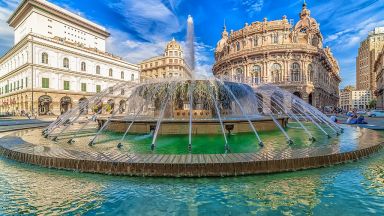
Raffaele Luigi De Ferrari, renowned as the Prince of Lucedio, Duke of Galliera, and esteemed senator of the Kingdom of Sardinia, displayed his acumen in 1837 when he acquired the entire collection of assets that had been bestowed by Napoleon I in 1812, procured through Prince Oscar of Sweden. His affluence was boundless, as was his status as a Grand Officer of the Order of Italy. These distinctions, while not exhaustive, were ample enough to lead to the christening of Genoa’s principal square in his name.
Spanning an expanse of 120,000 square feet, Ferrari Square stands at the heart of the city. In its midst stands an imposing bronze fountain, a grand creation brought to life in 1936 through the design prowess of architect Giuseppe Crosa di Vergagni.
The historical evolution of this square is fascinating. In 1814, the venerable Church of San Domenico made way for the construction of the magnificent Carlo Felice Theater, an architectural marvel designed by Carlo Barabino that was finally completed in 1827. Subsequently, in 1831, the two-story Linguistic Academy took up residence in this revered space.
The year 1877 marked a significant milestone, when the square was officially named Ferrari Square in honour of Raffaele Luigi De Ferrari, a year after his passing. A notable commemoration graced the square in 1893, with the striking equestrian statue of Giuseppe Garibaldi, a revered figure in the annals of Italian revolution, finding its place before the entrance of the Carlo Felice Theatre.
Over time, a quartet of imposing edifices showcasing eclectic architectural styles came into being. The New Stock Exchange Palace (Palazzo della Nuova Borsa) was unveiled in 1912, followed by the Palace of the Italian Credit (Palazzo del Credito Italiano) in 1914, and the Palace of the Liguria Region (Palazzo della Regione Liguria) in 1923.
Amid this dynamic urban landscape, historic structures also hold their ground. The Ducal Palace, originating from the 13th century and meticulously restored in 1992, stands as a beacon of cultural heritage, housing both a museum and a hub of intellectual exchange. The Giulio Pallavicini Palace, an architectural gem built in 1586, exudes timeless elegance. Equally notable is the Agostino Spinola Palace, a resplendent creation from the 18th century, which today serves as the Bank of Rome, a testament to the enduring significance of this remarkable square.
Location: Piazza De Ferrari, Piazza Raffaele de Ferrari, Genoa, Metropolitan City of Genoa, Italy | Hours: 24 Hours | Price: Free
Read more about Piazza De Ferrari
Palazzo Ducale (Doge's Palace)
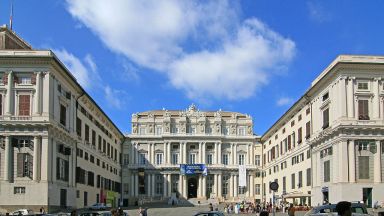
Once the residence of the Doges of Genoa, The Duke’s Palace stands as a testament to the city’s historical legacy. Nestled at the heart of the city, it can be accessed from both Matteotti Square and Ferrari Square. Its origins trace back to the 13th century, a pivotal period when Genoa was asserting itself as a dominant maritime force.
During that time, the leader of the state was known as the Captain of the People. However, the Captain and their entourage lacked a permanent residence, often finding shelter in the Archbishop’s Palace or the homes of prominent families like the Doria and Fieschi.
This situation underwent a significant transformation by 1294 when Corrado Doria, a Co-Captain of the People, and Oberto Spinola acquired the Doria family buildings and Alberto Fieschi’s mansion. These structures were amalgamated to create what later became the abbots’ palaces.
In the year 1339, Simone Boccanegra, also known as “Simon Blackmouth,” ascended to the position of Genoa’s first doge. This marked a turning point, and the palace was henceforth referred to as the “Duke’s Palace.” Over the 14th century, further architectural additions expanded the complex, while the 15th century saw the incorporation of a garrison building, culminating in the square’s transformation into a fortified courtyard.
Tragedy struck in the 18th century when a devastating fire consumed the palace. However, it was resurrected under the direction of architect Simone Cantoni. The reconstruction included a new marble facade and a redesign of the public spaces adorned with opulent gilded stucco and marble elements.
In the present day, this venerable center of authority serves a multifaceted purpose. It hosts exhibitions, meetings, special events, and functions as a library and museum. Notably, it represents Europe’s most extensive restoration endeavor, encompassing a sprawling 300,000-square-meter structure.
Location: Doge's Palace, Piazza Giacomo Matteotti, Genoa, Metropolitan City of Genoa, Italy | Hours: Visits to the tower and prison 10:00 - 13:00, 15:00 - 18:00. Mon closed. | Price: Tower and prison €5 | Website
Read more about Doge’s Palace (Palazzo Ducale) in Genoa
Cathedral of San Lorenzo
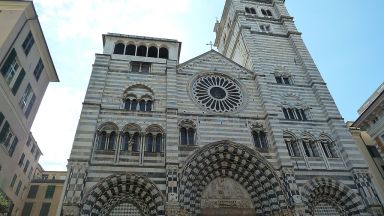
The Cathedral of San Lorenzo stands as the paramount ecclesiastical structure in Genoa. Its origins trace back to around 1098, and the inaugural ceremony was graced by Pope Gelasius II in 1118. With the fortification of the city’s walls, the vicinity surrounding San Lorenzo evolved into the pulsating heart of the city. During the medieval era, this church assumed the role of a central stage, profoundly influencing the social and political fabric of Genoa’s inhabitants.
A catastrophic fire in 1296 precipitated the church’s reconstruction, culminating in the completion of its facade in 1312. During this phase, the colonnades were meticulously refurbished, and matron galleries found their place. The comprehensive construction process spanned centuries, with final touches materializing in the 17th century. The subsequent restoration efforts of the dome and medieval sections occurred between 1894 and 1900.
The cathedral’s main facade is characterized by three resplendent Gothic portals embellished with recessed arches. Above the central portal, a lunette boasts reliefs portraying Christ alongside Saint Lawrence. Dominating the center portal, a sizable rose window emanates an exquisite radiance. The front steps are flanked by two stone lions and a pair of shorter columns. Adding to the facade’s allure are two unequal-height towers, gracing the vista with an imposing presence.
Internally, the cathedral adheres to a basilica plan, encompassing a transept and choir. Three naves are demarcated by columns bedecked in marble, crowned by arches characterized by alternating light and dark bands. Above this level, smaller Romanesque arches crafted from gray stone grace the space.
One of the side chapels on the left side is dedicated to Saint John the Baptist, the patron saint of Genoa. This sanctuary harbors an urn containing relics of the revered saint, transported here at the culmination of the First Crusade.
A curious historical footnote unfolded on February 9, 1941, when the Cathedral of Saint Lawrence found itself in the line of fire from the English battleship HMS Malaya. Remarkably, an armor-piercing shell penetrated a corner of the nave. Due to the relatively soft material, the fuse failed to detonate, resulting in the shell’s preservation within the structure. This intriguing artifact beckons your attention as you explore the cathedral.
Entry to the cathedral is free, yet admission fees apply for those wishing to access the treasure museum housed within its walls.
Location: Cathedral of San Lorenzo, Piazza San Lorenzo, Genoa, Metropolitan City of Genoa, Italy
Read more about Cathedral of San Lorenzo
Palazzo San Giorgio
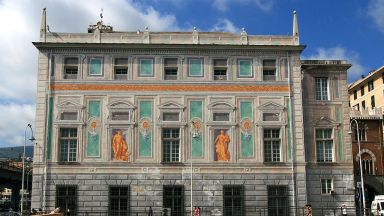
The Byzantine Emperor Michael VIII found himself indebted to Genoa due to their alliance during the conflict against the Latin Empire. In a gesture of gratitude, Emperor Michael contributed materials taken from the Venetian embassy in Constantinople to Guglielmo Boccanegra. With these resources, Boccanegra brought his waterfront palace aspirations to life in the year 1260.
The facade of Guglielmo’s magnificent palace was adorned with stone lions, symbols associated with Venice’s patron saint, Mark. However, this grandeur was short-lived, for merely two years later, Boccanegra was ousted from his role as Captain of the People and compelled into exile. The palace’s function transitioned into that of a prison, housing the likes of Marco Polo, whose captivating memoirs were dictated to Rustichello of Pisa. This accomplished romance writer notably collaborated with Marco Polo in crafting his autobiography, “The Travels of Marco Polo,” during their shared imprisonment.
Originally conceived to serve as the hub for port authorities, the palace’s design was entrusted to Frate Oliverio, a Cistercian monk. By the year 1400, the edifice transformed into the headquarters of the Bank of San Giorgio, a pioneering Italian financial institution.
In 1570, an Eastern wing was incorporated, housing customs offices, archives, and the secure vaults of the bank. Subsequently, in 1608, the main facade was adorned with heroic frescoes, with the centerpiece featuring the depiction of Saint George and the dragon. The roof above the central portion of the facade saw the addition of a clock tower.
Adorning the facade’s niches are statues commemorating iconic figures from Genoa’s history. This distinguished lineup includes Christopher Columbus, Andrea Doria, Biagio Assereto, Simone Boccanegra, Guglielmo Embriaco, and Caffaro di Rustico.
In the present day, the Palace of St. George serves as the administrative nucleus of the Port, embodying a convergence of history and contemporary utility.
Location: Palazzo San Giorgio, Palazzo San Giorgio, Genoa, Metropolitan City of Genoa, Italy | Hours: Open every day except Sundays, from 9: 00 a.m. to 12:30 p.m. and from 4:00 p.m. to 7:00 p.m. Only open from 4:00 p.m. to 7:00 pm on Mondays.
Read more about Palazzo San Giorgio
Porto Antico di Genova
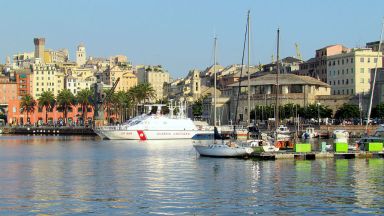
The Genoa Old Port serves as a nostalgic gateway to the city’s illustrious past as a prominent maritime hub and sea-faring powerhouse. With a keen focus on catering to tourists, the Old Port seamlessly conjures the essence of bygone eras. Within its expanse, visitors can feast their eyes on an eclectic mix of historical galleons, contemporary sleek yachts, and imposing cruise ships, all nestled in the harbor.
Encompassing a blend of offerings, the Old Port boasts an array of restaurants, museums, an engaging aquarium, a dynamic auditorium, a unique botanical garden encapsulated within a bubble, and a colossal octopus crane that elevates visitors for an enhanced vista of the captivating Genoa Old Port. This harbor proves to be an idyllic setting for a leisurely sunset stroll, affording panoramic views of the sea while still immersed within the city’s embrace. Even a moonlit walk holds its own allure.
The realization of this transformation was achieved under the visionary guidance of Renzo Piano, a globally acclaimed architect hailing from Genoa. His vision aimed to breathe new life into the timeworn industrial expanse of the old port, converting it into a cultural epicenter and a prime destination for tourists.
A noteworthy milestone in this rejuvenation was the International Exhibition Genoa ’92 – Colombo ’92, which unfolded from May to August. Reverberating with the theme “Christopher Columbus, the Ship, and the Sea,” the event commemorated the 500th anniversary of Columbus’ momentous voyage to the New World. It concurrently marked the unveiling of the revitalized Genoa Old Port, solidifying its place as a timeless testament to the city’s maritime heritage and modern-day allure.
Location: Porto Antico di Genova, Italy
Read more about Porto Antico di Genova
Galata Museo del Mare (Galata Maritime Museum)
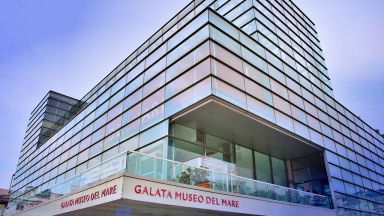
The term “Galata” refers to the historical Genoese enclave situated in Istanbul, Turkey. This enclave held a position of paramount importance among the Genoese colonies in the Mediterranean. However, by the 15th century, their presence in this community had waned. In the 19th century, the Genoa municipality embarked on the construction of an expansive network of commercial docks, and the oldest of these docks bore the name of the erstwhile lost colony.
Galata thrived as a vibrant shipyard where Genoese galleys were meticulously crafted. As the 20th century unfolded, Genoa’s maritime prominence underwent transformation, leading to the eventual abandonment of the district. The 1990s marked a pivotal turning point when the decision was made to establish a maritime museum within the Galata district. The Galata Palace, meticulously revitalized by architect Guillermo Consuegra, was designated as the museum’s home.
Subsequently, the museum opened its doors in 2004. In 2005, it amalgamated with the Commenda Museum-Theatre and the Naval Museum of Pegli, evolving into the Institute of Museums of the Sea and Migration.
The museum’s ground floor unfolds the saga of galleys, featuring a life-size model of a 17th-century galley and an exhibition showcasing armour, weaponry, portraits of noteworthy figures like Columbus and Andrea Doria, alongside an array of documents, charts, and navigational tools.
The first and second floors are a tribute to sailing and shipyards, housing a reproduction of a Brigantine, a shipyard workshop display, and an immersive experience simulating a tempestuous ordeal off Cape Horn. The third floor is dedicated to the grand era of Transatlantic liners, boasting a mockup ship’s bridge and a simulation detailing an immigrant’s journey from Gibraltar to New York.
Notably, the museum’s dock serves as a mooring site for the submarine Nazario Sauro, an intriguing floating extension of the museum experience.
Location: Galata Museo del Mare, Calata Ansaldo De Mari, Genoa, Metropolitan City of Genoa, Italy | Website
Read more about Galata Museo del Mare (Maritime Museum)
Palazzo Reale (Royal Palace Museum)
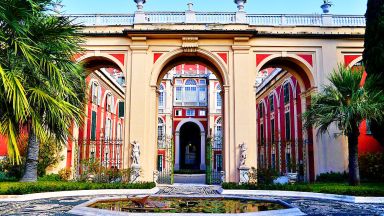
The Balbi family’s prosperity stemmed from their involvement in the silk trade and financial ventures. In the 17th century, they brought their aspirations to life by constructing a magnificent palace, a marvel that now holds a revered spot on the esteemed list of World Heritage Sites.
Tragedy struck Stefano and Giovanni Battista Balbi, as they fell victim to the devastating plague of 1657. Subsequently, the palace exchanged hands and found new owners in the Durazzo family. The Durazzo lineage, originating from Albania and having evolved into prosperous merchants in Genoa, took charge of the palace’s legacy.
In the year 1823, the Royal Savoia family entered the picture, acquiring the palace. King Carlo Felice di Savoie utilized the palace as his summer residence, adding another layer of historical significance. From 1919 onward, the palace has been under state ownership.
Today, the palace serves as the domicile for Liguria’s Department for Artistic, Historical, and Archaeological Heritage and the Royal Palace Museum. Notably, each room within the palace boasts a distinct interior style, contributing to a captivating tapestry of design.
The Battle Room pays homage to naval engagements of the 18th century through vivid paintings. The Hall of Time showcases an assemblage of 23 masterpieces by Tintoretto and Bassano. Meanwhile, the Hall of the Veronese features a 17th-century replica of “The Supper of Christ in the House of Simon the Pharisee.”
Drawing inspiration from the Versailles Ice Gallery, the Hall of Mirrors is a creation by Domenico Parodi for Girolamo II Durazzo. This opulent space was once employed as a grand dining hall, hosting luminaries such as Emperor Joseph II of Austria and Napoleon Bonaparte.
Lastly, the Chapel Gallery is a haven dedicated to the Passion of Christ. Among its treasures is a striking portrayal of Christ at the Column, a masterpiece painted by Filippo Parodi.
Location: Palazzo Reale, Via Balbi, Genoa, Metropolitan City of Genoa, Italy | Website
Read more about Palazzo Reale , Genoa
Basilica of the Santissima Annunziata del Vastato
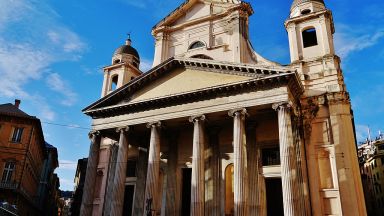
The term “vastato” has its roots in the Latin word “vastinium.” This term signifies a strip of land lying beyond the city walls that was cleared for defensive purposes. The Basilica of the Santissima Annunziata del Vastato was erected beyond the city’s protective walls. The inception of its construction took place in 1520 under the auspices of the Franciscans, situated on the former grounds of the Church of Santa Maria del Prato.
However, progress was halted in 1537 and only recommenced in 1591, under the patronage of the Lomellini family. Architect Taddeo Carlone spearheaded the continuation of the construction. During the 17th century, Baroque embellishments were incorporated, guided by the artistic direction of painter Andrea Ansaldo. The contemporary Neoclassical facade, a creation of Carlo Barabino, was integrated between 1830 and 1840.
A Latin portico, adorned with a triangular roof, stands as the entrance to the basilica. This feature is supported by six ionic stone columns and two pilasters. The facade’s upper portion is embellished with two lunette windows, with the smaller window positioned above the larger one. Flanking the facade are two bell towers, adding to the basilica’s architectural grandeur.
Internally, the church follows a Latin cross layout, with three naves divided by rows of Corinthian columns and arches. This arrangement forms an exquisite setting that resembles a 17th-century art gallery. The interior is bedecked with opulent inlaid marble, ornate gilded stucco, and frescoes contributed by 23 local artists and sculptures by 13 craftsmen. The result is a sumptuous visual feast that captures the essence of artistry and devotion.
Location: Santissima Annunziata del Vastato, Piazza della Nunziata, Genoa, Metropolitan City of Genoa, Italy
Read more about Basilica of the Santissima Annunziata del Vastato
Spianata di Castelletto (Esplanade of Castelletto)
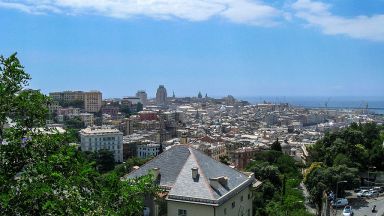
The term “Castelletto” means “little castle.” It generally refers to a neighborhood, not a mini fortress. There was a small fortress overlooking Genoa proper. It was built in the 10th century and torn down in the 19th century to clear room for residential buildings.
When the Castelletto was demolished, it left behind the Belvedere Montaldo, a vantage point 240 feet high offering great views of Genoa proper. The best way to reach the Belvedere is the public lift in Portale Square, described as the best route to heaven by the poet Giorgio Caproni. The lift terminus is a beautiful art nouveau tower.
It is not widely known that the city’s old reservoirs, which collected water from the ancient aqueduct over the Bisagno Valley, are located under the ruin of the Castelletto.
The Esplanade of Castelletto neighborhood is in the hills above the city. It is a real neighborhood, ideal for afternoon or evening explorations. It is easily reached from the city center.E
Location: Spianata Castelletto, Spianata di Castelletto, Genoa, Metropolitan City of Genoa, Italy
Read more about Soianata Castelletto
Via Giuseppe Garibaldi (Giuseppe Garibaldi Street)
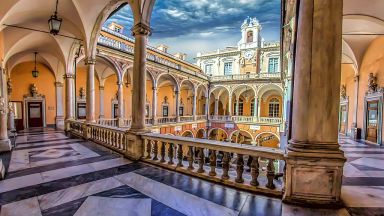
Giuseppe Garibaldi Street stands as one of the captivating “New Streets” that emerged during the Renaissance era, a testament to the vision of Genoese aristocrats. Constructed in 1583, the street initially bore the names Major Street (Strada Maggiore) or New Street (Strada Nuova). In 1882, it was bestowed the name Giuseppe Garibaldi. The street spans 956 feet in length and spans 25 feet in width.
During the 16th and 17th centuries, the affluent oligarchs of Genoa harbored aspirations to reshape their medieval city and expand it into the northern regions. The city was basking in unprecedented opulence, equipped with ample resources to fuel its urban expansion ambitions. The elite, brimming with nobility and prosperity, envisioned a city adorned with opulent palaces and splendid villas nestled in the outskirts.
The street’s nomenclature underwent transformation, evolving from New Street and Major Street to the evocative Golden Street (Strada Aurea). Ultimately, in 1882, the name solidified as Giuseppe Garibaldi Street. Along this notable avenue, the New Street Museum complex finds its place, flanked by three prominent palaces: Doria Tursi Palace (which serves as the Town Hall), White Palace, and Podesta Palace.
During the days of the Republic, the city maintained Rolli, curated lists cataloging the most magnificent homes and palaces belonging to noble families. These illustrious abodes would host significant state visits. Depending on the visitor’s stature, a palace would be designated as the host venue. Notably distinguished guests were afforded the most sumptuous, opulent accommodations.
Twice each year, in both spring and autumn, Genoa ushers in Rolli Days. On these weekends, the exquisite edifices lining Giuseppe Garibaldi Street fling open their doors to welcome the public within their ornate confines.
Charles Dickens, in his work “Pictures from Italy,” eloquently penned: “…When shall I forget the Streets of Palaces: the Strada Nuova and the Strada Balbi!…again, and again, and again,…every palace is succeeded by another…” These streets are a captivating facet of Genoa that never ceases to surprise and inspire.
Location: Palazzo Doria Tursi, Via Garibaldi, Genoa, Metropolitan City of Genoa, Italy | Hours: From 1st Novemeber From Tuesday to Friday 9 am - 6.30 pm Saturday and Sunday 9.30 am - 6.30 pm Closed: MondayFrom 18 April from Tuesday to Friday 9 am - 7 pm Saturday and Sunday 10 am - 7,30 pm Closed on non-holiday Mondays Last admission one hour before closing | Price: The Genova Museum Card is a single ticket, valid for 24 hours , which allows you to access only once the 28 city museums, 19 civic museums and 9 non-civic museums, for the price of 15 euro inclusive of AMT public transport | Website
Read more about Via Garibaldi Palaces
This website uses affiliate links which earn a small commission at no additional cost to you.
